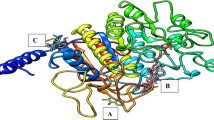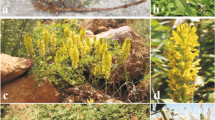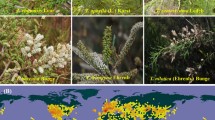Natural products have been conventional in traditional medicine and still used presently to cure many diseases. In the present study, extracts of two plants – Olea europaea and Syzygium aromaticum – were tested for their phytochemical compositions, cytotoxic effect on hepatocellular carcinoma cells, and chemical profile of the most active fractions. Both plants were extracted with 85% methanol and then fractionated with various solvents. Hemolysis and cytotoxicity effects on normal (Vero) and hepatocellular carcinoma (HepG2) cells were examined. Chemical profiles were studied using GC-MS and chromatographic isolation on silica gel. Phytochemical screening revealed that both plants contain carbohydrates, saponins and flavonoids, while steroids were found only in O. europaea and alkaloids were found only in S. aromaticum. Hemolysis assay showed complete safety of O. europaea, while S. aromaticum exhibited low toxicity. Furthermore, the EtOAc fraction of O. europaea and BuOH fraction of S. aromaticum showed the best IC50 against HepG2. The GC-MS analysis of EtOAc fraction of O. europaea revealed 15 compounds, the major one being α-linoleic acid methyl ester, and the chromatographic separation of BuOH fraction of S. aromaticum resulted in a pure compound of 3-O-methyl-butyrate-6,7,3',4'-tetrahydroxy-5-methoxy-8-methylflavan. Thus, the study proved that the two title plants have components possessing cytotoxic activity against HepG2 cells.






Similar content being viewed by others
References
P. Temin, Pharmacogn. J., 8(4), 395 – 398 (2016).
G. E. Batiha, L. M. Alkazmi, L. G. Wasef, et al., Biomolecules, 10(202), 1 – 16 (2020).
F. Mujeeb, P. Bajpai, and N. Pathak, Biomed Res. Int., 2014, 497606 (2014).
M. V. Gavrilin, A. V. Sedin, and S. P. Senchenko, Pharm. Chem. J., 46(6), 360 – 362 (2012).
R. García-Villalba, A. Carrasco-Pancorbo, C. Oliveras-Ferraros, et al., J. Pharm. Biomed. Anal., 51(2), 416 – 429 (2010).
R. Ghanbari, F. Anwar, K. M. Alkharfy, et al., Int. J. Mol. Sci., 13(3), 3291 – 3340 (2012).
M. Fezai, L. Senovilla, M. Jemaa, et al., J. Lipids, 2013, 1 – 7 (2013).
S. Marino, C. Festa, F. Zollo, et al., Anticancer Agents Med. Chem., 14(10), 1376 – 1385 (2014).
B. Ryu, H. M. Kim, J. S. Lee, et al., J. Agric. Food Chem., 64(15), 3048 – 3053 (2016).
R. Astuti, S. Listyowati, and W. Wahyuni, IOP Conf. Ser. Earth Environ. Sci., 299, 012059 (2019).
W. T. Eden, D. Alighiri, N. Wijayati, et al., Pharm. Chem. J., 55(3), 269 – 274, (2021).
M. I. Nassar, Carbohydr. Res., 341(1), 160 – 163 (2006).
M. R. Farag and M. Alagawany, Chem. Biol. Interact., 279, 73 – 83 (2018).
W. M. Rashed, M. A. M. Kandeil, M. O. Mahmoud, et al., J. Egypt Natl. Cancer Inst., 32(1), 5 (2020).
H. W. Sim and J. Knox, Curr. Probl. Cancer, 42(1), 40 – 48, (2018).
J. Bielawski, BBA Gen. Subj., 1035(2), 214 – 217, (1990).
E. A. Morsi, H. O. Ahmed, H. Abdel-Hady, et al., Curr. Bioact. Compd., 16(9), 1306 – 1318, (2020).
H. Okasha, S. Samir, and S. M. Nasr, Bioorg. Chem., 115, 105266 (2021).
H. Abdel-Hady, S. M. Nasr, and E. A. El-Wakil, Int. J. Pharm. Res., 11(2), 418 – 426 (2019).
N. Savithramma, M. L. Rao, and S. Ankanna, Middle-East J. Sci. Res., 5(4), 100 – 103 (2015).
A. Prashar, I. C. Locke, and C. S. Evans, Cell Prolif., 39(4), 241 – 248, (2006).
P. S. Kumar, R. M. Febriyanti, F. F. Sofyan, et al., Pharmacogn. Res., 6(4), 350 – 354, (2014).
S. N. Malik, Int. J. Pharmacogn. Phytochem. Res., 7(2), 307 – 310 (2015).
S. O. Jimoh, L. A. Arowolo, and K. A. Alabi, Int. J. Curr. Microbiol. Appl. Sci., 6(7), 4557 – 4567 (2017).
L. Garba, H. Lawan, H. U. Puma, et al., J. Biochem. Microbiol. Biotechnol., 7(1), 5 – 9 (2019).
R. Naz, T. H. Roberts, A. Bano, et al., PLoS One, 15(7), e0236319 (2020).
A. Zaïri, S. Nouir, A. Zarrouk, et al., Food Sci. Nutr., 8(9), 4805 – 4813 (2020).
W. Yi, C. C. Akoh, J. Fischer, and G. Krewer, Food Res. Int., 39(5), 628 – 638 (2006).
D. Slameòová, E. Horváthová, L. Wsólová, et al., Mutat. Res. Toxicol. Environ. Mutagen., 677(1), 46 – 52 (2009).
A. Maalej, Z. Bouallagui, F. Hadrich, et al., Biomed. Pharmacother., 90, 179 – 186 (2017).
S. K. Minasyan, T. A. Rozovskaya, M. K. Kukhanova, et al., Pharm. Chem. J., 23(10), 791 – 794 (1989).
M. Dallons, C. Schepkens, A. Dupuis, et al., Front. Pharmacol., 11, 79 (2020).
S. N. Deshpande and D. G. Kadam, Asian J. Pharm. Clin. Res., 6, 99 – 101 (2013).
A. A. Al-Huqail, G. A. Elgaaly, and M. M. Ibrahim, Saudi J. Biol. Sci., 25(7), 1420 – 1428 (2018).
R. Devery, A. Miller, and C. Stanton, Biochem. Soc. Trans., 29(2), 341 – 344 (2001).
V. Chajes, F. Lavillonnière, V. Maillard, et al., Nutr. Cancer., 45(1), 17 – 23 (2003).
A. Sati, S. C. Sati, N. Sati, et al., Nat. Prod. Res., 31(6), 713 – 717 (2017).
E. El-Demerdash, Toxicol. Appl. Pharmacol., 254(3), 238 – 244 (2011).
R. D. Breeta, V. M. Grace, and D. D. Wilson, Basic-Clin. Pharmacol. Toxicol., 128(3), 366 – 378 (2021).
M. Pinto, S. Araújo, M. Morais, et al., Acad. Bras. Sci., 89(3), 1671 – 1681 (2017).
H. W. Lin, I. Saul, V. L. Gresia, et al., Transl. Stroke Res., 5(1), 109 – 117 (2014).
D. S. El-Agamy, M. A. Elkablawy, and H. M. Abo-Haded, Cancer Chemother. Pharmacol., 79(2), 399 – 409 (2017).
A. B. Hamed, E. M. Mantawy, W. M. El-Bakly, et al., Futur. J. Pharm. Sci., 6(1), 31 (2020).
R. Takeara, P. C. Jimenez, D. V. Wilke, et al., Comp. Biochem. Physiol. A: Mol. Integr. Physiol., 151(3), 363 – 369 (2008).
M. Skoula, R. J. Grayer, G. C. Kite, et al., Biochem. Syst. Ecol., 36(8), 646 – 654 (2008).
R. A. Susidarti, R. I. Jenie, M. Ikawati, et al., J. Appl. Pharm. Sci., 4(6), 89 – 97 (2014).
G. R. Kahiking, R. Rumampuk, and E. Pongoh, Fuller. J. Chem., 5(2), 53 (2020).
CONFLICT OF INTEREST
The authors declare that they have no conflicts of interest.
Funding
This work was based upon a research project (Grant No#128/K) supported by Theodor Bilharz Research Institute (TBRI), Giza, Egypt.
Author information
Authors and Affiliations
Corresponding author
Rights and permissions
Springer Nature or its licensor (e.g. a society or other partner) holds exclusive rights to this article under a publishing agreement with the author(s) or other rightsholder(s); author self-archiving of the accepted manuscript version of this article is solely governed by the terms of such publishing agreement and applicable law.
About this article
Cite this article
Okasha, H., Abdel-Hady, H., Morsi, E.A. et al. In Vitro Cytotoxic Activity and Identification of Bioactive Compounds Isolated from Olea europaea and Syzygium aromaticum Plants. Pharm Chem J 56, 1123–1132 (2022). https://doi.org/10.1007/s11094-022-02761-5
Received:
Published:
Issue Date:
DOI: https://doi.org/10.1007/s11094-022-02761-5




